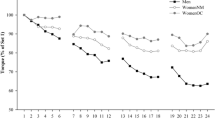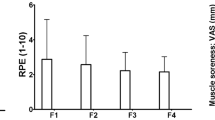Abstract
The present study aimed to analyze the magnitude of muscle damage and inflammatory responses induced by eccentric exercise in young (YW) and postmenopausal women (PMW). Seventeen healthy women (nine YW, 23.89 ± 2.03 years; and eight PMW, 51.13 ± 5.08 years) performed five sets of six maximal eccentric actions of the elbow flexors. Changes in isometric strength, range of motion, muscle soreness, and upper-arm circumference were evaluated pre, post, 24, 48, and 72 h following eccentric exercise. Changes in creatine kinase activity, interleukin 6 (IL-6), interleukin 10 (IL-10), tumor necrosis factor-α (TNF-α), and prostaglandin E2 (PGE2) were measured pre, 24, 48, and 72 h following eccentric exercise. For intra and inter-group analysis, a two-way repeated measures ANOVA was applied followed by a Tukey’s post hoc test. Pearson’s correlation was used to analyze the correlations between variables. It was observed no differences between groups for the markers of muscle damage, although significant modifications (p < 0.05) occurred within groups throughout time for all variables. Post menopausal women showed significantly higher values for TNF-α (p < 0.05). Also, IL-6 presented superior pre value for PMW. For YW, IL-6 and IL-10 values increased 72 h post-eccentric exercise compared to pre. Further, IL-10 was higher for YW than PMW 72 h post-eccentric exercise. Significant correlations (p < 0.05) were found between age and soreness, and between age and PGE2. In conclusion, YW do not have attenuated muscle damage compared to PMW who do not make use of hormonal replacement therapy. In addition, YW have a greater anti-inflammatory response after eccentric exercise compared to PMW.



Similar content being viewed by others
References
Bassit RA, Curi R, Costa Rosa LF (2008) Creatine supplementation reduces plasma levels of pro-inflammatory cytokines and PGE2 after a half-ironman competition. Amino Acids 35(2):425–431
Bruunsgaard H, Skinhoj P, Pedersen AN, Schroll M, Pedersen BK (1999) A high plasma concentration of TNF-alpha is associated with dementia in centenarians. J Gerontol A Biol Sci Med Sci 54(7):M357–M364
Bruunsgaard H, Skinhoj P, Pedersen AN, Schroll M, Pedersen BK (2000a) Ageing, tumour necrosis factor-alpha (TNF-alpha) and atherosclerosis. Clin Exp Immunol 121(2):255–260
Bruunsgaard H, Skinhoj P, Pedersen AN, Schroll M, Pedersen BK (2000b) TNF-alpha, leptin, and lymphocyte function in human aging. Life Sci 67(22):2721–2731
Carter A, Dobridge J, Hackney AC (2001) Influence of estrogen on markers of muscle tissue damage following eccentric exercise. Fiziol Cheloveka 27(5):133–137
Chedraui P, Jaramillo W, Perez-Lopez FR, Escobar GS, Morocho N, Hidalgo L (2011) Pro-inflammatory cytokine levels in postmenopausal women with the metabolic syndrome. Gynecol Endocrinol 27(9):685–691
Cheung K, Hume P, Maxwell L (2003) Delayed onset muscle soreness: treatment strategies and performance factors. Sports Med 33(2):145–164
Chung HY, Cesari M, Anton S, Marzetti E, Giovannini S, Seo AY, Carter C, Yu BP, Leeuwenburgh C (2009) Molecular inflammation: underpinnings of aging and age-related diseases. Ageing Res Rev 8(1):18–30
Clarkson PM, Hubal MJ (2002) Exercise-induced muscle damage in humans. Am J Phys Med Rehabil 81(11 Suppl):S52–S69
Close GL, Kayani A, Vasilaki A, McArdle A (2005) Skeletal muscle damage with exercise and aging. Sports Med 35(5):413–427
Davies RC, Rowlands AV, Poole DC, Jones AM, Eston RG (2011) Eccentric exercise-induced muscle damage dissociates the lactate and gas exchange thresholds. J Sports Sci 29(2):181–189
Davis JM, Murphy EA, Carmichael MD, Zielinski MR, Groschwitz CM, Brown AS, Gangemi JD, Ghaffar A, Mayer EP (2007) Curcumin effects on inflammation and performance recovery following eccentric exercise-induced muscle damage. Am J Physiol Regul Integr Comp Physiol 292(6):R2168–R2173
Delaney MF (2006) Strategies for the prevention and treatment of osteoporosis during early postmenopause. Am J Obstet Gynecol 194(2 Suppl):S12–S23
Dinarello CA, Gatti S, Bartfai T (1999) Fever: links with an ancient receptor. Curr Biol 9(4):R147–R150
Ebbeling CB, Clarkson PM (1989) Exercise-induced muscle damage and adaptation. Sports Med 7(4):207–234
Faul F, Erdfelder E, Lang AG, Buchner A (2007) G*Power 3: a flexible statistical power analysis program for the social, behavioral, and biomedical sciences. Behav Res Methods 39(2):175–191
Fischer CP, Berntsen A, Perstrup LB, Eskildsen P, Pedersen BK (2007) Plasma levels of interleukin-6 and C-reactive protein are associated with physical inactivity independent of obesity. Scand J Med Sci Sports 17(5):580–587
Guyton AC, Hall JE (2002) Tratado de fisiologia médica, 10th edn. Guanabara Koogan, Rio de Janeiro
Hamada K, Vannier E, Sacheck JM, Witsell AL, Roubenoff R (2005) Senescence of human skeletal muscle impairs the local inflammatory cytokine response to acute eccentric exercise. Faseb J 19(2):264–266
Hirose L, Nosaka K, Newton M, Laveder A, Kano M, Peake J, Suzuki K (2004) Changes in inflammatory mediators following eccentric exercise of the elbow flexors. Exerc Immunol Rev 10:75–90
Hurley BF, Roth SM (2000) Strength training in the elderly: effects on risk factors for age-related diseases. Sports Med 30(4):249–268
Kaplanski G, Farnarier C, Kaplanski S, Porat R, Shapiro L, Bongrand P, Dinarello CA (1994) Interleukin-1 induces interleukin-8 secretion from endothelial cells by a juxtacrine mechanism. Blood 84(12):4242–4248
Kendall B, Eston R (2002) Exercise-induced muscle damage and the potential protective role of estrogen. Sports Med 32(2):103–123
Larson-Meyer DE, Newcomer BR, Heilbronn LK, Volaufova J, Smith SR, Alfonso AJ, Lefevre M, Rood JC, Williamson DA, Ravussin E (2008) Effect of 6-month calorie restriction and exercise on serum and liver lipids and markers of liver function. Obesity (Silver Spring) 16(6):1355–1362
Lavender AP, Nosaka K (2006a) Changes in fluctuation of isometric force following eccentric and concentric exercise of the elbow flexors. Eur J Appl Physiol 96(3):235–240
Lavender AP, Nosaka K (2006b) Comparison between old and young men for changes in makers of muscle damage following voluntary eccentric exercise of the elbow flexors. Appl Physiol Nutr Metab 31(3):218–225
Lavender AP, Nosaka K (2008) Changes in markers of muscle damage of middle-aged and young men following eccentric exercise of the elbow flexors. J Sci Med Sport 11(2):124–131
Malm C, Nyberg P, Engstrom M, Sjodin B, Lenkei R, Ekblom B, Lundberg I (2000) Immunological changes in human skeletal muscle and blood after eccentric exercise and multiple biopsies. J Physiol 529(Pt 1):243–262
Nosaka K, Newton M, Sacco P (2002) Delayed-onset muscle soreness does not reflect the magnitude of eccentric exercise-induced muscle damage. Scand J Med Sci Sports 12(6):337–346
Ostrowski K, Rohde T, Zacho M, Asp S, Pedersen B (2008) Evidence that interleukin-6 is produced in human skeletal muscle during prolonged running. J Physiol 1:949–953
Paschalis V, Nikolaidis MG, Theodorou AA, Giakas G, Jamurtas AZ, Koutedakis Y (2010) Eccentric exercise affects the upper limbs more than the lower limbs in position sense and reaction angle. J Sports Sci 28(1):33–43
Peake J, Nosaka K, Suzuki K (2005a) Characterization of inflammatory responses to eccentric exercise in humans. Exerc Immunol Rev 11:64–85
Peake JM, Suzuki K, Wilson G, Hordern M, Nosaka K, Mackinnon L, Coombes JS (2005b) Exercise-induced muscle damage, plasma cytokines, and markers of neutrophil activation. Med Sci Sports Exerc 37(5):737–745
Pedersen BK, Steensberg A, Schjerling P (2001) Muscle-derived interleukin-6: possible biological effects. J Physiol 536(Pt 2):329–337
Petersen AM, Pedersen BK (2005) The anti-inflammatory effect of exercise. J Appl Physiol 98(4):1154–1162
Smith LL (1991) Acute inflammation: the underlying mechanism in delayed onset muscle soreness? Med Sci Sports Exerc 23(5):542–551
Stupka N, Lowther S, Chorneyko K, Bourgeois JM, Hogben C, Tarnopolsky MA (2000) Gender differences in muscle inflammation after eccentric exercise. J Appl Physiol 89(6):2325–2332
Taaffe DR, Sipila S, Cheng S, Puolakka J, Toivanen J, Suominen H (2005) The effect of hormone replacement therapy and/or exercise on skeletal muscle attenuation in postmenopausal women: a yearlong intervention. Clin Physiol Funct Imaging 25(5):297–304
Thompson HS, Scordilis SP, De Souza MJ (2006) Serum creatine kinase activity varies with ovulatory status in regularly exercising, premenopausal women. Horm Res 65(3):151–158
Tiidus PM (2003) Influence of estrogen on skeletal muscle damage, inflammation, and repair. Exerc Sport Sci Rev 31(1):40–44
Uchida MC, Nosaka K, Ugrinowitsch C, Yamashita A, Martins E Jr, Moriscot AS, Aoki MS (2009) Effect of bench press exercise intensity on muscle soreness and inflammatory mediators. J Sports Sci 27(5):499–507
Acknowledgments
The authors would like to express gratitude for the extracurricular project of weight training and fitness (Faculty of Physical Education of State University of Campinas—UNICAMP) and the National Council of Technological and Scientific Development of Brazil (CNPq) for the financial support to the present research. Also the authors would like to show appreciation to the volunteers that participated on this study.
Conflict of interest
The authors declare that they have no conflict of interest.
Author information
Authors and Affiliations
Corresponding author
Additional information
Communicated by Susan A. Ward.
Rights and permissions
About this article
Cite this article
Conceição, M.S., Libardi, C.A., Nogueira, F.R.D. et al. Effects of eccentric exercise on systemic concentrations of pro- and anti-inflammatory cytokines and prostaglandin (E2): comparison between young and postmenopausal women. Eur J Appl Physiol 112, 3205–3213 (2012). https://doi.org/10.1007/s00421-011-2292-6
Received:
Accepted:
Published:
Issue Date:
DOI: https://doi.org/10.1007/s00421-011-2292-6




